Wholesale stun guns for security companies offer a cost-effective and efficient solution for crowd control and enhancing security operations. Projectile stun weapons provide strategic distance targeting, while contact stun guns ensure immediate close-range protection. Security professionals must undergo rigorous training and adhere to legal guidelines for responsible deployment, balancing personal safety, public order, and preventing misuse.
In the realm of personal safety and security, stun weapons have emerged as a controversial yet effective deterrent. This article delves into the two primary types: projectile and contact stun devices. Understanding their unique mechanisms and applications is crucial for security professionals considering wholesale stun guns. We explore the range and effectiveness of each, legal implications, training requirements, and a comparative analysis to guide users in making informed decisions, ensuring responsible deployment in self-defense scenarios.
- Understanding Projectile Stun Weapons: Mechanisms and Range
- Contact Stun Guns: Direct Impact and In-Close Combat Effectiveness
- Wholesale Stun Guns: Security Companies' Perspective on Cost and Efficiency
- Legal Considerations: Regulations for Stun Weapon Ownership and Use
- Safety and Training: Responsible Deployment of Stun Devices
- Comparative Analysis: Projectile vs Contact for Self-Defense Scenarios
Understanding Projectile Stun Weapons: Mechanisms and Range
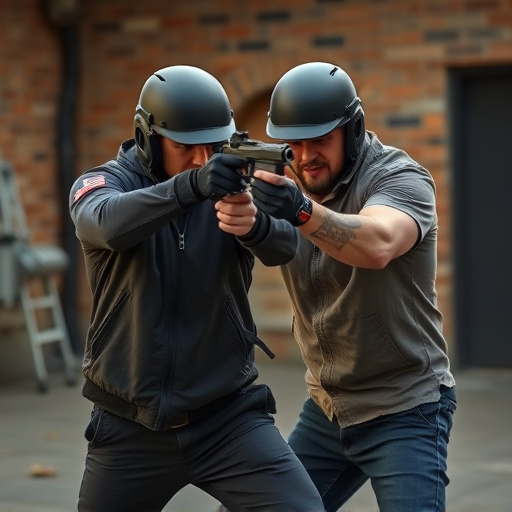
Projectile stun weapons, a popular choice for personal defense and security applications, operate by propelling a high-velocity projectile designed to temporarily incapacitate a target. These devices typically use spring-loaded mechanisms or compressed gases to launch non-lethal projectiles such as rubber bullets, bean bags, or specialized round balls. The primary mechanism behind their effectiveness lies in the kinetic energy transferred from the projectile to the target, causing temporary muscle spasms and disorientation.
The range of these weapons varies depending on factors like design, ammunition type, and environmental conditions. In general, projectile stun guns offer a longer effective reach compared to contact-based stun devices. Wholesale stun guns for security companies often focus on models that provide a balance between power, accuracy, and range. This ensures that security personnel can incapacitate potential threats from a distance, making them valuable tools for crowd control and high-risk situations where minimizing physical contact is crucial.
Contact Stun Guns: Direct Impact and In-Close Combat Effectiveness
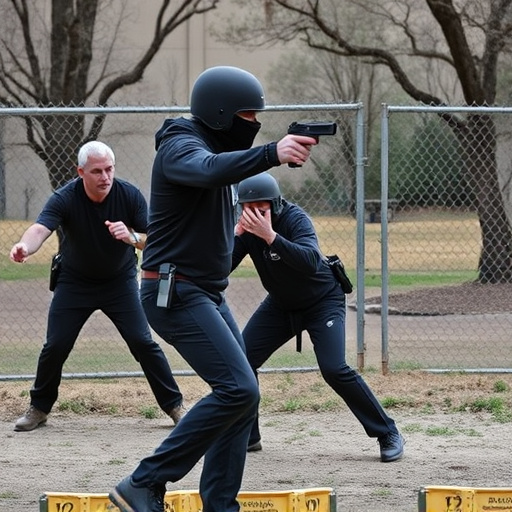
Contact stun guns are designed for direct impact and in-close combat situations, making them a preferred choice for security professionals who operate in close proximity to potential threats. These weapons deliver a powerful electric shock through a solid metal probe or bar that makes contact with the target’s vital areas, such as the nerve centers and muscle groups. The immediate effect is a severe disruption of motor functions, causing the individual to lose balance, fall to the ground, and become temporarily incapacitated.
For security companies seeking wholesale stun guns for their fleet, contact stun guns offer several advantages in controlled, up-close scenarios. Their effectiveness lies in the direct application of force and electricity, ensuring a swift and reliable neutralization. This is particularly useful during high-stress situations where speed and precision are paramount, making them invaluable tools for close protection details, VIP security, and tactical response teams.
Wholesale Stun Guns: Security Companies' Perspective on Cost and Efficiency
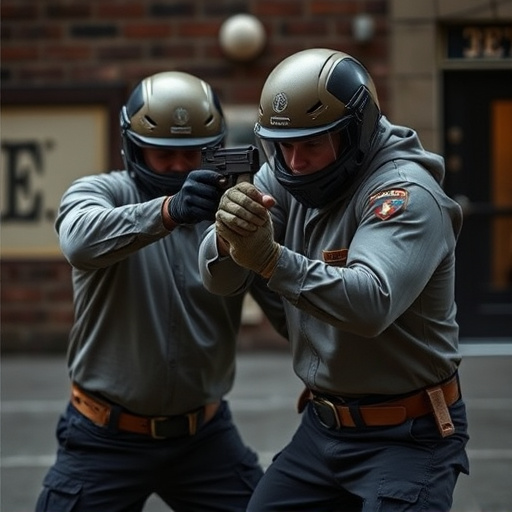
Security companies often face a critical decision when it comes to choosing between projectile and contact stun weapons for their operations. One option gaining traction is the use of wholesale stun guns, which offer a cost-effective and efficient solution for crowd control and security enhancement. These devices provide an immediate non-lethal response, enabling security personnel to de-escalate potentially dangerous situations swiftly.
The advantages of wholesale stun guns are significant from a financial perspective. They typically require less maintenance than traditional weapons and have lower operational costs over time. Moreover, their ease of use ensures that security guards can respond quickly during emergencies, making them valuable assets for companies aiming to improve safety measures without substantial investment.
Legal Considerations: Regulations for Stun Weapon Ownership and Use
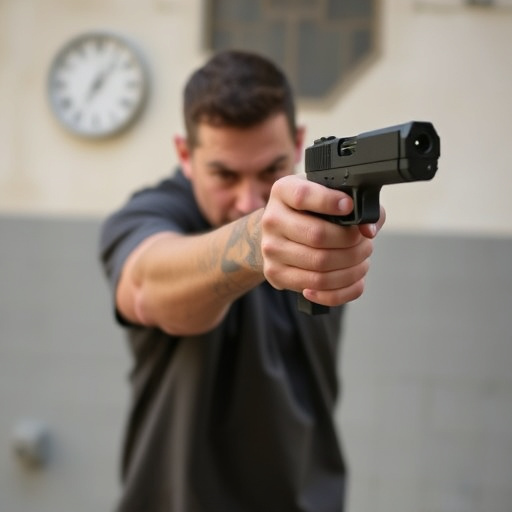
Stun weapons, whether projectile or contact-based, operate under a legal framework that varies significantly across jurisdictions worldwide. The regulations around stun gun ownership and use are often nuanced, reflecting societal concerns regarding personal safety, public order, and potential misuse. For security companies specializing in wholesale stun guns, understanding these legal considerations is paramount.
Many countries and states require licenses or permits for the possession of stun devices, with specific rules governing their type, power output, and use. Some jurisdictions limit stun weapon sales to law enforcement agencies and authorized personnel only, while others permit private citizens to own them under certain conditions. Regulations also dictate how stun guns can be advertised, sold, and transported, emphasizing the responsibility of retailers and distributors in ensuring compliance with local laws. These measures are designed to promote safe and responsible use while mitigating risks associated with potential misuse or accidental deployment.
Safety and Training: Responsible Deployment of Stun Devices
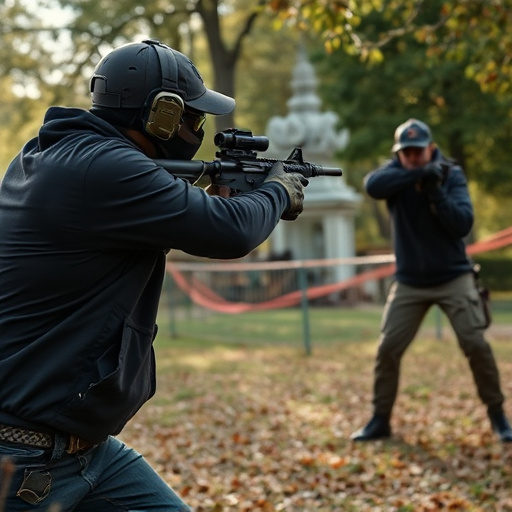
The responsible deployment of stun devices, whether projectiles or contact weapons, requires rigorous safety training and adherence to legal guidelines. For security companies dealing in wholesale stun guns, it’s paramount to ensure their personnel are adequately equipped with knowledge on safe handling practices. This includes understanding the device’s range, activation mechanisms, and de-activation procedures. Regular simulations and real-world scenarios can help train officers to make quick, effective decisions while minimizing collateral damage and ensuring public safety.
Moreover, security companies should maintain a strict policy for weapon storage, transport, and inventory management. Stun devices, like any other less-lethal weaponry, require secure holding areas accessible only to authorized personnel. Comprehensive training in the responsible deployment of stun guns is key to preventing accidents and misuse, thereby enhancing public trust and safety in high-risk environments.
Comparative Analysis: Projectile vs Contact for Self-Defense Scenarios

When it comes to self-defense scenarios, both projectile and contact stun weapons have their merits. Projectile weapons like stun grenades and rubber bullet guns offer a strategic advantage by allowing users to target attackers from a distance, making them ideal for crowded or hazardous environments. This feature is particularly appealing for security companies looking to equip their guards with wholesale stun guns for effective yet non-lethal force deployment.
On the other hand, contact stun devices such as electric stun guns and batons provide immediate close-range protection. They are designed to incapacitate an assailant with a powerful electrical shock upon direct contact, making them straightforward and reliable in high-stress situations. This direct approach ensures that the user has complete control over the situation, providing an additional layer of safety when facing armed or aggressive individuals.
In conclusion, both projectile and contact stun weapons offer unique advantages in self-defense scenarios. Projectile weapons provide a safe, non-lethal range option, while contact guns excel in close-quarters combat. For security companies seeking effective yet cost-efficient solutions, wholesale stun guns can be a viable investment. However, responsible deployment necessitates proper training and adherence to legal regulations, ensuring the safety of both users and bystanders. Understanding these nuances is key to making informed decisions regarding personal or professional protection equipment choices.
